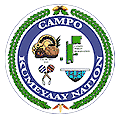FOR IMMEDIATE RELEASE
February 27, 2010
Campo Tribe Proposes Landfill
BY ONELL R. SOTO, UNION-TRIBUNE STAFF WRITER
SATURDAY, FEBRUARY 27, 2010 AT 1:44 A.M.
The Campo Indian band is reviving a plan to build a huge landfill on its East County reservation near the Mexican border.
The 320-member tribe says the plan is much improved from two earlier efforts beginning in the 1980s that ultimately faltered amid concerns from neighbors about its effects on traffic and water.
“The science is different, our groundwater protection processes are better, our monitoring and environmental-management practices have become even stronger and we have new landfill technologies we did not have then,” tribal Chairwoman Monique LaChappa said in a prepared statement.
The tribe is proposing to lease the land for the project to BLT Enterprises, an Oxnardbased recycling company. The project would be BLT’s first landfill.
The 493-acre Campo Regional Landfill, surrounded by a square-mile buffer area, would be on reservation land and thus not subject to county regulations and state environmental laws, which are among the toughest in the nation. The project must adhere to federal and tribal laws, and the tribe says its environmental regulations are as strict as California’s.
But the project is sure to stir up the same kind of battles as earlier proposals.
“There’s no way that we can accept the burial of that amount of imported garbage over our only source of water,” said activist Donna Tisdale, who lives on a ranch adjacent to the landfill site.
“We’re going to litigate any approvals,” she said. Lawsuits by Tisdale’s group, Backcountry Against Dumps, were instrumental in defeating earlier proposals.
Every day for about some 30 years, the landfill would accept about 138 truckloads of trash from San Diego County and elsewhere, and use 37,000 gallons of water pumped from nearby wells, according to a draft environmental report released yesterday.
The capacity of 3,000 tons a day could accommodate about 15 percent of San Diego County’s needs.
When environmental effects were last reviewed, in 1992, the project was predicted to increase air pollution, destroy the habitats of sensitive plant and animal species, and blight the landscape.
Some proposed changes would make up for that damage, according to the documents released yesterday. For instance, dust can be kept down.
But other problems can’t be avoided, such as the noise from heavy equipment dumping garbage and covering it with topsoil, the addition of industrial activity near homes and the appearance of the landfill to neighbors.
The new proposal eliminates a former plan to bring in garbage by train and to have recycling and composting operations at the landfill. The changes would mean fewer permanent jobs at the landfill, 15 rather than more than 50.
Also new are changes to the thickness of the liner underneath the waste, the amount of dirt that will be used to cover it, and the added possibility of using methane from decomposing garbage to generate electricity.
The company says the landfill will exceed state, federal and tribal standards to make sure no contamination reaches groundwater.
“We’ve done substantial additional work on understanding the groundwater regime out there,” said Rick Morck, a consultant who is project engineer for BLT.
And even if contaminated water leaks through the landfill lining, a monitoring system will catch it in time to fix it, he said.
County Supervisor Dianne Jacob said the thicker lining and monitoring systems aren’t enough when talking about possibly contaminating the only source of water for miles around.
“There’s no evidence that any kind of a landfill — it doesn’t matter how many layers they have — is not going to leak,” she said. “This is the wrong location for a landfill.”
She said she plans to ask the Bureau of Indian Affairs to reject the landfill proposal.
The tribe and BLT say the landfill is needed to meet the region’s disposal needs.
But increased recycling efforts —and a faltering economy — have made it possible for existing landfills to last years beyond previous forecasts.
The three big landfills in the county are all taking in less waste than a few years ago, said Neil Mohr, general manager of Allied Waste, which owns two of them, Otay and Sycamore. San Diego’s Miramar Landfill is the third.
“We’re down 20 percent,” he said.
Landfill capacity is expected to increase at Miramar and Sycamore, he said, and a new landfill north of Escondido may open in the next few years.
“With the redesigns of the facilities and the expansions, we have certainly a minimum of 15, and really probably 40 years of disposal capacity approved,” he said.
Still, he said, there’s room for additional landfills in the county.
The county’s waste plan was last updated in 2005, when experts predicted there was enough landfill space for needs until 2017 or 2018.
“Things have changed,” said Wayne Williams, who leads the county’s planning efforts. “There’s more space available than we previously estimated,” he said.
The Campo landfill proposal will require approval from the Bureau of Indian Affairs, the U.S. Environmental Protection Agency and the Fish and Wildlife Service before going before the Campo tribal government’s environmental protection agency for a permit.
The Campo band owns a quarry; the Golden Acorn Casino & Travel Center; one wind farm, Kumeyaay Wind, and is planning a second on its 24-square-mile reservation 60 miles east of downtown San Diego.
The Bureau of Indian Affairs, which would have to approve the lease with BLT, is planning to hold public hearings on the landfill April 13 at the Campo Tribal Center on the reservation, and April 14 at the Mountain Empire High School in Buckman Springs. Both meetings will begin at 6 p.m. More information, including copies of the environmental documents, is available at campodseis.com. People have 75 days to comment on the Campo proposal.
###
© 2010 Union Tribune

